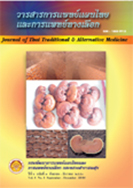A Study of the Botanical Origin and Essential Oil Components of the Herb Phak Chee La
Main Article Content
Abstract
Phak chee la is a crude drug commonly used in Thai traditional herbal remedies. Fruits of phak chee la are used as an antiflatulent, mineral supplement, thirst quencher, anti-nausea/vomiting and treatment for sore eye. Despite its availability in Thai herbal drugstores, the botanical identity and the official scientific
name of phak chee la is still unclear. There is also no obvious definition of the name “phak chee la” and there are several plants called “phak chee” in Thailand, such as phak chee Lao, phak chee loom, and phak chee jean. To reveal its botanical origin, the crude drug was traced back from herbal dispensaries in Bangkok to its natural habitats in combination with the information gathered from interviews with traditional healers and the data from intensive literature reviews. Fruits of phak chee la were purchased from several herbal dispensaries in Bangkok and Chiang Mai. Evaluation of crude drugs was conducted according to Thai Herbal Pharmacopeia guidelines as well as the determination of the chemical content of essential oils made from phak chee la fruits. According to the studies, the content of foreign matter, acid-insoluble ash, total ash and moisture was determined; the amounts were as follows: 0.07 ± 0.01, 0.003 ± 0.001, 7.25 ± 0.40 and 1.93 ± 0.28%, whereas the ethanol-soluble extractive, and water-soluble extractive were determined to be 4.42 ± 0.03, 3.28 ±
0.22%, respectively. The major components in the oil extracted from the fruits of phak chee la were linalool, camphor, gamma-terpinene and alpha-pinene. The overall chemistry study in combination with the information obtained in the interviews and literature reviews supported the botanical origin of the crude drug phak che la to be Coriandrum sativum L. However, further studies on such aspects as plant genetics and chemistry are necessary for confirmation.
Article Details
References
2.ชุมนุมแพทย์แผนไทยและสมุนไพรแห่งชาติครั้งที่ ๖ การดูแลสุขภาพแบบไทยสัปปายะ. ศูนย์พัฒนาตำราการแพทย์แผนไทย สถาบันมส่งเสริมการแพทย์แผนไทย มูลนิธิการแพทย์แผนไทย; ๒๕๔๗. หน้า ๑-๒.
3.ประมวลสรรพคุณยาไทย (ภาคสอง) ว่าด้วยพฤกษชาติ วัตถุธาตุและสัตว์วัตถุนานาชนิด. (ม.ป.ป.). กรุงเทพฯ: สมาคม ร.ร.แพทย์แผนโบราณสำนักวัดพระเชตุพนฯ (วัดโพธิ์);๒๕๒๑ หน้า ๑๗๔.
4.เย็นจิตร เตชะดำรงสิน, วิชัย โชควิวัฒน. การตรวจสอบสมุนไพร. เอกสารประกอบการสัมมนาเชิงปฏิบัติการ เรื่องการตรวจสอบสมุนไพร. กรมพัฒนาการแพทย์แผนไทยและแพทย์ทางเลือก; ๒๕๔๗.
5.กรมวิทยาศาสตร์การแพทย์ กระทรวงสาธารณสุข. Thai Herbal Pharmacopoeia. Volume l. กรุงเทพฯ: บริษัท ประชาชื่น จำกัด;๒๕๓๘.
6.กรมวิทยาศาสตร์ การแพทย์ กระทรวงสาธารณสุข. Thai Herbal Pharmacopoeia. Volume ll. กรุงเทพฯ:บริษัทประชาชื่น จำกัด ; ๒๕๔๓.
7. Msaada K, Hosni K, Taarit BM, Chahed T, Kchouk EM, Marzouk B. Changes on essential oil composition of coriander (Coriandrum sativum L.) fruits during three stages of maturity. J Food Chem 2007;102(4):1131-4.
8.ประเทืองศรี สินชัยศรี. พรรณพืชหอมและน้ำมันหอมระเหย นนทบุรี: สำนักพิมพ์ นีออน บุ๊ค มีเดีย ; ๒๕๔๗. หน้า ๕๔-๕๕.
9.พิมพร ลีลาพรพิสิฐ. สุคนธบำบัด. กรุงเทพฯ: โอ.เอส.พริ้นติ้ง เฮ้าส์;๒๕๔๗ หน้า ๑-๕.
10. Diederichsen A. Coriander Coriandrum sativum L. International Plant Genetic Resources Institute; 1996. p. 43.
พจนานุกรมฉบับราชบัณฑิตยสถาน พ.ศ. ๒๕๔๒, พิมพ์ครั้งที่ ๑. กรุงเทพฯ: นานมีบุ๊คส์พับลิเคชั่นส์; ๒๕๔๖. หน้า ๓๖๕, ๑๐๐๕.
12. Singh D, Gangwar B. Management practices for higher productivity of coriander in India-a review. Agri Revol Karnal 1991;12:15-21.
13. Figueiredo RO, Marques MOM, Nakagawa J, Ming LC. Composition of coriander essential oil from Brazil. ISHS Acta Horticulturae XXVI International Horticultural Congress: The Future for Medicinal and Aromatic Plants 2002; 629.
14. Machado ASR, De Azevedo EG, Da Ponte MN, Sardinha RMA. High pressure carbon dioxide extraction from Coriander plants, Headspace Analysis. J Essent Oil Res 1993;5:645-9.
15. Duke J. The Green Pharmacy, The Ultimate Compendium of Natural Remedies from the Worldûs Foremost Authority on Healing and Herbs. 1997; 336-7.
16. Diederichsen A, Hammer K, The intraspecific taxa of coriander (Coriandrum sativum L.). Genetic Resources Crop Evolution 2003;50:33-63.


